Introduction
Budget vs Actual Variance Analysis is a strategic tool that aligns financial expectations with operational reality. By comparing projections with actuals, financial leaders can decode the narratives behind any deviations and refine forecasting methods. This article explores the importance of analyzing budget variances, calculating and interpreting variances, and best practices for conducting a budget variance analysis.
It also addresses common challenges and provides solutions to enhance the efficiency of budgeting activities. Mastering budget variance analysis is crucial for CFOs to steer their organizations towards financial stability and growth in today's ever-changing business environment.
What is Budget vs Actual Variance Analysis?
Budget vs Actual Variance Analysis transcends mere number-crunching; it is a strategic tool that aligns an organization's financial expectations with its operational reality. By rigorously comparing projections with actuals, financial leaders can decode the narratives behind any deviations, be it underspending due to overestimated market demand or cost overruns from unforeseen economic shifts. This analysis is not static; it adapts as lessons are drawn from each fiscal period. With insights garnered from variance analysis, companies can refine their forecasting methods. For example, Monte Carlo Simulations have been utilized to project completion dates for product releases, especially when products form part of critical infrastructure and are updated infrequently. This probabilistic approach allows for more nuanced planning and can be pivotal in scheduling and resource allocation. Such techniques are particularly beneficial when products require physical delivery, such as shipping. Variance analysis also serves as a reality check against expert opinions, reminding us that even well-established methods like Story Points estimation can be fallible and should be continuously challenged. It's a clarion call for adaptability and skepticism in equal measure, urging businesses to critically evaluate expert-derived strategies and tailor them to their unique context. As Mike Tyson famously said, "Everyone has a plan, until they get punched in the mouth." Variance analysis is the financial equivalent of rolling with the punches, ensuring that businesses stay agile and responsive to the ever-evolving market landscape.
Why Analyze Budget vs Actual Variances?
As financial landscapes evolve, the analysis of budget vs actual variances becomes increasingly essential for businesses to maintain a competitive edge. This process is not solely about numbers; it reflects the company's aspirations and operational efficiency. For instance, the CMO Survey highlights the significance of correlating marketing budgets with total sales, emphasizing the importance of proportionate spending in relation to company size and market presence.
Healthcare organizations are a testament to the challenges of disparate systems and manual processes that lead to inefficiencies. A physician organization's experience with cumbersome reporting—requiring three analysts for a single report—underscores the necessity for streamlined procedures and the adoption of technologies like automation to enhance financial report accuracy and timeliness.
To avoid the pitfalls of fragmented budget management, it's imperative to appoint a dedicated lead for the budget planning process. By integrating marketing operations with finance, companies can mitigate misunderstandings and align departmental budgets with overarching company goals, as advocated by business leaders.
Understanding cash flow—the essence of any thriving business—is fundamental to budget planning. A business budget template serves as an invaluable tool, simplifying the financial planning process and enabling informed decision-making. Additionally, it's vital to distinguish between fixed costs and variable expenses to accurately forecast and manage financial resources.
The narrative of Netflix and Blockbuster's rivalry, as recounted by Christensen, illustrates the perils of ignoring marginal costs and revenues in investment decisions. As companies plan for the future, it's crucial to maintain a growth mindset and consider the long-term value potential, as suggested by the Rule of X.
Ultimately, budget analysis is not a static exercise but a dynamic process that requires continuous monitoring and adaptation to ensure alignment with the strategic direction of the business. This agility in financial management can serve as a catalyst for growth and success in the ever-changing business environment.
Calculating Budget Variance
Variance analysis is a fundamental tool for financial management, shedding light on discrepancies between projected budgets and actual financial outcomes. It functions as a financial barometer, offering insights into areas where an organization is overperforming or underperforming. Positive variances occur when actual revenues surpass expectations or when expenditures are lower than anticipated, signaling efficient resource utilization or higher-than-expected income. Conversely, negative variances indicate overspending or revenue shortfalls, necessitating adjustments to financial strategies or operational efficiencies.
The value of variance analysis extends beyond mere number-crunching. For instance, in the non-profit sector, the impact of financial decision-making can be profound. Donors often scrutinize the effectiveness of their contributions, akin to how consumers assess product quality and value. Just as market research employs AI and machine learning to enhance accuracy and timeliness in predicting consumer behavior and trends, so too can these technologies revolutionize financial forecasting and variance analysis, providing CFOs with nuanced, data-driven insights to steer their organizations towards optimal financial health.
Real-time data analysis enables more responsive decision-making, contrasting with the slower pace of traditional forecasting methods, which may take months to yield actionable insights. This advanced approach to forecasting is crucial for organizations to maintain a competitive edge and achieve their financial objectives.
In-depth budget planning involves more than just tallying expenses; it narrates the financial story of an organization's projects and initiatives. A detailed budget reveals not only the cost but also the rationale behind each expenditure, aligning financial planning with strategic goals and values. Furthermore, as technology continues to intertwine with business strategies, IT infrastructure investments become pivotal. This is exemplified by the global spending on tech goods and services, representing a trillion-dollar industry, underlining the significance of IT budgeting in today's digital era.
By embracing sophisticated tools and methodologies for variance analysis, CFOs can ensure their organizations are allocating resources efficiently, maximizing impact, and achieving sustainable growth.
Budget Variance Formula
Understanding the nuances of budget variance is crucial for effective financial management. The formula for calculating budget variance is relatively straightforward: subtract the budgeted amount from the actual amount, then divide that result by the budgeted amount. However, to truly grasp its implications, one must consider the underlying factors, such as bias and variance.
Bias in this context refers to systematic deviations from the budget, perhaps due to overly optimistic revenue projections or underestimating expenses. Variance, on the other hand, captures random fluctuations that can cause actual figures to differ from the budgeted ones. These can stem from unforeseen market dynamics or operational challenges.
Budget variance analysis serves as a valuable tool, not just for accountability, but also as a strategic instrument to guide future spending and investment decisions. As organizations invest in their operations—be it through technology, infrastructure, or human capital—the ability to predict and manage financial outcomes becomes paramount. For instance, the role of technology in organizational success has led to a significant portion of budgets being allocated to IT infrastructure, highlighting the importance of precise budgeting and variance analysis.
In education, the concept of budget equity emphasizes the fair distribution of resources, ensuring that each student receives an equal opportunity to succeed. The allocation of funds must consider various factors, such as socioeconomic status and special education needs, to achieve this goal.
As Mike Tyson famously said, 'Everyone has a plan, until they get punched in the mouth.' This adage holds true for financial planning as well—budgets are a plan that must be adaptable. Regular monitoring and adjustments are necessary to respond to the dynamic nature of business and ensure that organizations remain on the right track.
In conclusion, the budget variance formula is a starting point for deeper analysis. By understanding the factors that contribute to variance and bias, and by applying strategic thinking to the allocation of resources, organizations can navigate the complexities of financial planning and steer towards their long-term goals.
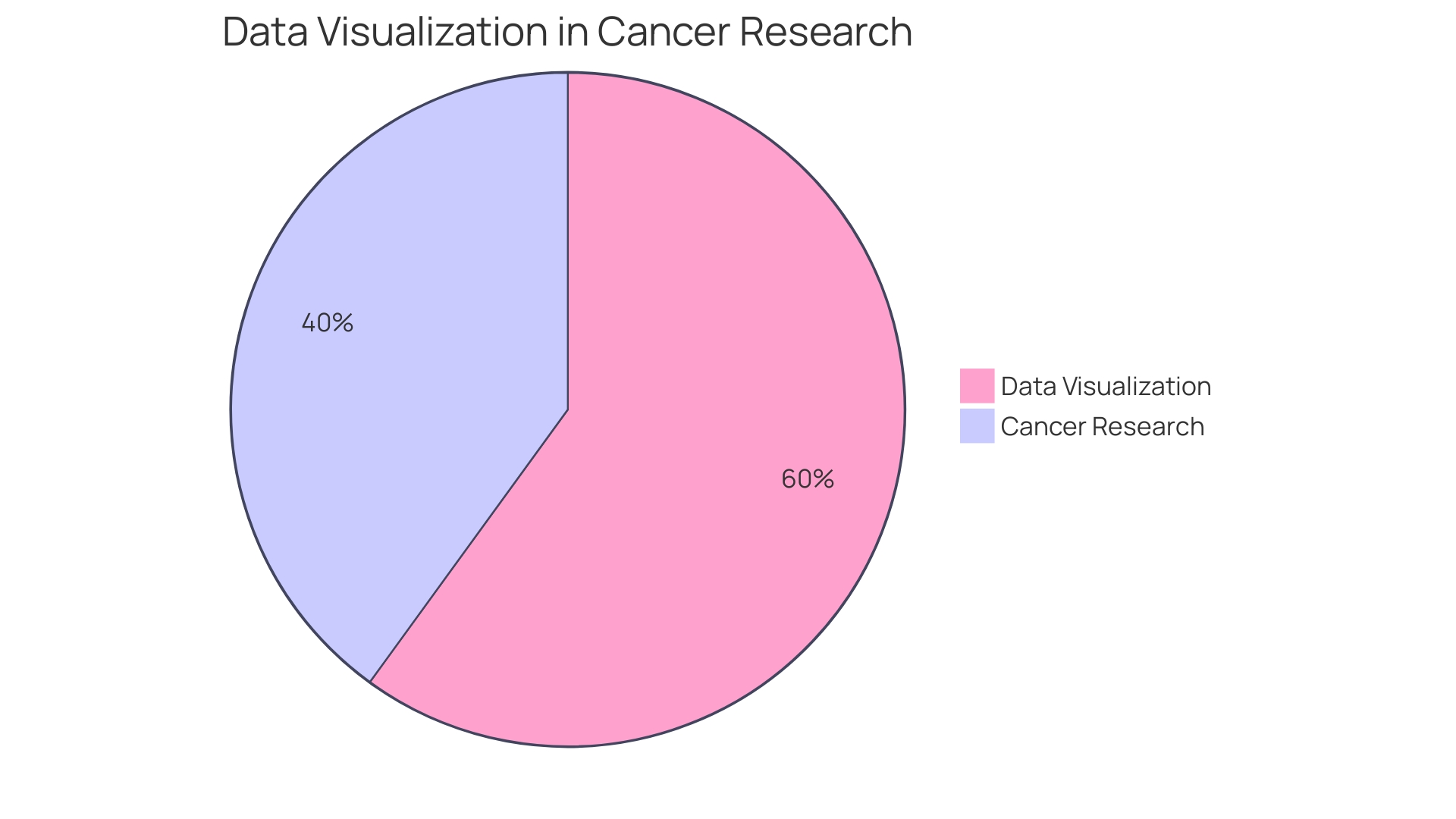
Percentage Variance Calculation
Calculating percentage variance is a pivotal tool for financial analysis, enabling the quantification of budget discrepancies in relation to the planned financial targets. To compute this, one applies the formula:
Percentage Variance = (Budget Variance / Budgeted Amount) * 100%
This metric transforms the budget variance into a proportionate figure, thereby facilitating a more nuanced assessment of financial performance. It offers a universal gauge to comprehend the severity of variances, irrespective of the budget size. For instance, a 5% variance on a $1,000 budget reflects a $50 difference, whereas the same percentage on a $1,000,000 budget signifies a $50,000 variance, highlighting the importance of context in financial analysis.
Types of Budget Variances
In the dynamic world of business finance, understanding and managing budget variances is pivotal. These variances are deviations from the financial plan, and they come in different forms, each with its implications on a company's fiscal health. Revenue variances highlight discrepancies between actual and projected income, which can signal shifts in market conditions or internal performance issues. Expense variances, on the other hand, uncover differences in actual spending versus budgeted figures, often prompting a review of cost controls or operational efficiency. Labor variances shed light on the actual labor costs against forecasts, which are crucial for organizations to manage workforce expenses effectively. Material variances reflect the variance in actual material costs as compared to the budget, which can be an indicator of supply chain effectiveness or pricing strategy success. Lastly, overhead variances compare the actual overhead with the budgeted costs, offering insights into the management of ongoing operational expenses. By vigilantly monitoring these variances, businesses can fine-tune their financial strategies for optimal performance.
Rate and Volume Variances
Understanding rate and volume variances is crucial for businesses to manage production and sales efficiency effectively. Rate variance highlights the difference when the actual cost of a unit differs from the planned cost, impacting the overall budget. For instance, if a company anticipates spending $5 per unit but ends up spending $6, the rate variance would be $1 per unit. Volume variance, on the other hand, occurs when the actual quantity of units produced or sold deviates from the budgeted amount. This could be due to changes in demand, production line efficiency, or external market factors.
Real-world examples help illustrate these concepts. Consider a retail strategy, known as the loss-leader theory, where a store may reduce the price of a popular item to attract customers. Although this creates a rate variance due to the reduced price, the strategy can lead to an increase in overall sales volume, potentially offsetting the initial loss. Similarly, production efficiency can be seen in Ford's early assembly lines or Starbucks' operations, where the focus is on maximizing total factor productivity (TFP) to produce more within a shorter time frame, affecting both rate and volume variances.
In the context of budgeting, for example, school districts allocate resources through allotments for specific purposes, which can reflect the principles of equity in distribution. This implies managing rate and volume variances to ensure funds are utilized effectively, without compromising the quality of education or operational efficiency.
Furthermore, forecasting models, like the one developed for Auchan Ukraine and later adapted for Romania and France, are designed to predict demand at the store and SKU levels. Such models are essential for managing volume variances, as they help in anticipating sales trends and adjusting production accordingly.
In the broader financial landscape, government departments and bodies like the Treasury must manage debt issuance with an awareness of rate and volume variances, as they directly influence the cost of borrowing and the efficiency of debt management strategies. According to the Treasury, maintaining regular and predictable debt issuance and responding to market conditions are key to managing these variances.
In conclusion, whether it is in retail, manufacturing, education, or government finance, understanding and managing rate and volume variances are vital for maintaining budget integrity and achieving financial objectives. Tools and strategies to analyze and adjust for these variances are indispensable for financial leaders aiming to steer their organizations towards stability and growth.
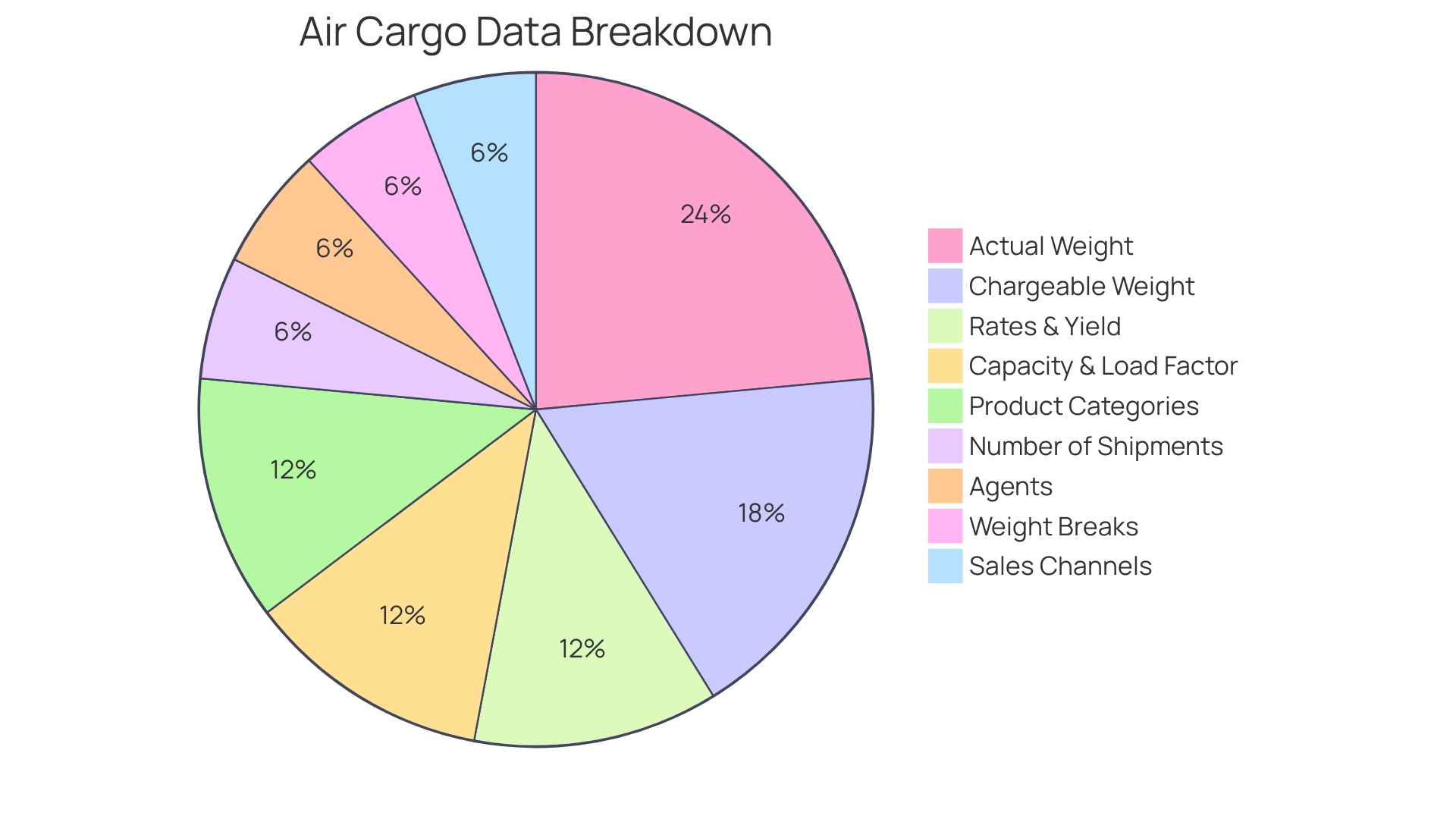
Interpreting and Analyzing Variances
Analyzing budget versus actual variances is a multifaceted process that delves into the root causes of discrepancies in financial expectations versus realities. Such analysis not only uncovers the variances but also sheds light on the underlying dynamics that led to these differences. For instance, a company may realize that its actual spending on technology exceeded budgeted amounts. This could be due to a strategic decision to invest more heavily in IT infrastructure, reflecting a global trend where businesses are increasing their technology budgets to drive success and maintain a competitive edge in a digitally transforming landscape.
When approaching variance analysis, it's important to initially define the problem with precision—what specific variances are we examining, and why are they significant? Next comes the collection of relevant data. This could range from internal financial reports to broader market data. For example, a company might discover through its variance analysis that its sales projections were off due to unanticipated changes in consumer behavior or a shift in market conditions. Such insights are crucial for recalibrating business strategies.
Furthermore, variance analysis can benefit from cutting-edge analytical tools such as Monte Carlo Simulations. These tools help in understanding the potential range of outcomes and can be particularly useful for companies with complex products or services. As an example, a company that releases updates in large batches due to customer preferences for stable, on-premise solutions can employ Monte Carlo Simulations to better predict feature completion and manage release schedules.
Incorporating insights from variance analysis into business operations can lead to more informed decision-making. Let's take the case of a business grappling with technical debt and product updates. By understanding the financial impact of these factors through variance analysis, the company can prioritize its resources more effectively, perhaps by allocating more budget towards addressing technical debt to avoid cost overruns in the future.
Ultimately, the goal of variance analysis is not just to account for differences but to use those insights to steer the company towards more efficient operations and strategic financial planning. Companies that embrace a rigorous approach to variance analysis, armed with the right data and tools, position themselves to navigate uncertainties and optimize their financial performance.
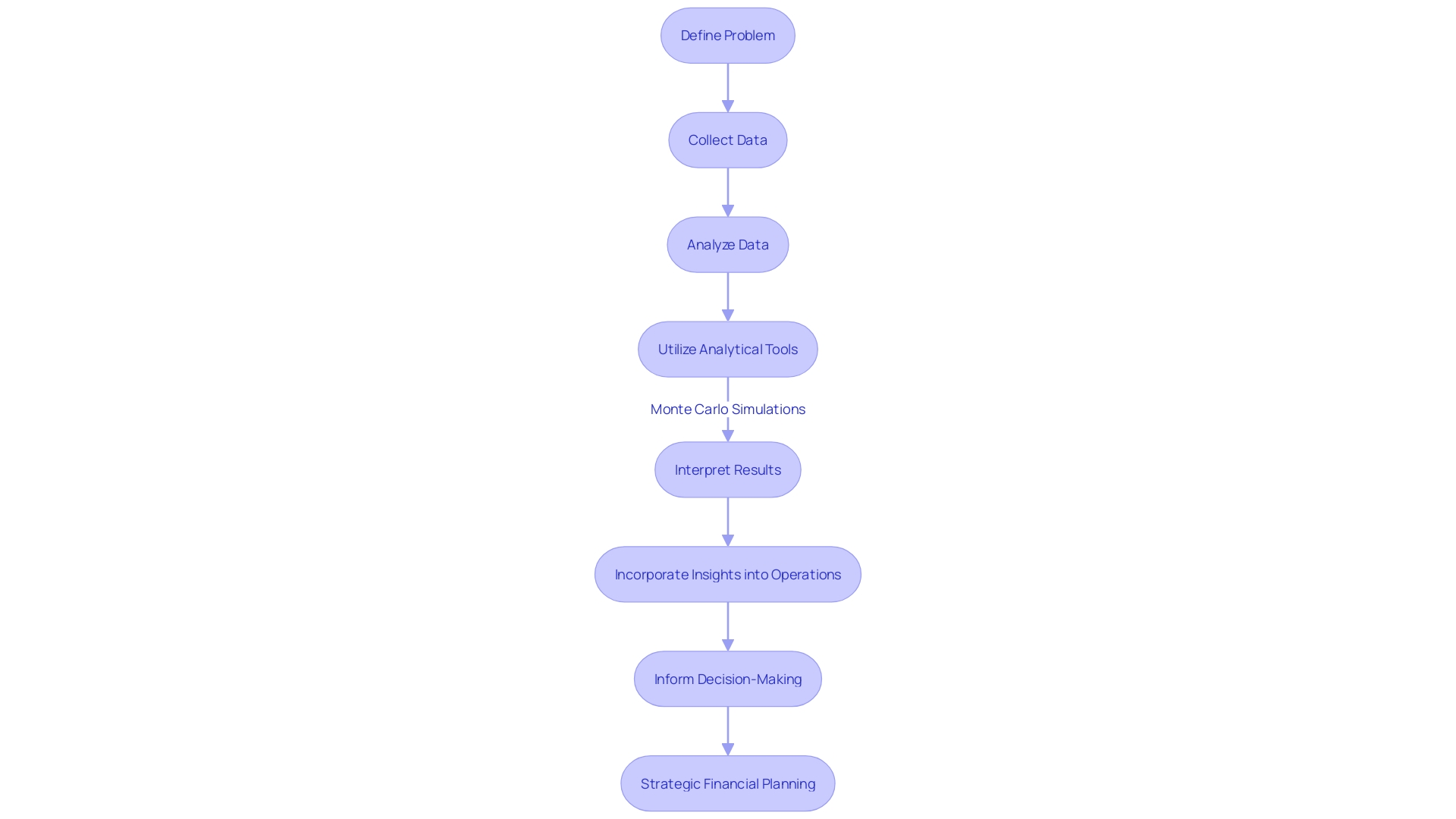
Steps to Perform a Budget Variance Analysis
To effectively conduct a budget variance analysis, the following crucial steps should be meticulously executed:
-
Collate both the projected budget and the actual financial figures. This initial stage is vital for laying the groundwork for a comprehensive analysis.
-
Determine the variances within each financial category. This involves calculating the differences between what was expected and what was actually spent or earned.
-
Delve into the variances to uncover underlying causes. A thorough examination is essential to understanding the factors contributing to any discrepancies.
-
Implement corrective measures informed by your findings. This step is about taking action to address any issues identified during the analysis.
-
Continuously monitor performance and adjust the budget accordingly. This iterative process ensures that the organization remains agile and can respond to changing financial landscapes.
It's important to note, as Jurgen Appelo suggests, that in today's fast-paced business environment, traditional annual budget cycles can be limiting. Instead, adapting budgets based on actual performance could provide more flexibility and negate the need for strict budgets.
Moreover, investing in your organization demands a clear understanding of potential solutions and their expected return on investment (ROI). This strategic approach to spending is imperative for maximizing the impact of your financial resources.
Integrating these steps into the financial strategy allows for a dynamic approach to financial management, aligning with the real-time demands of the organization and ensuring that every dollar is spent judiciously for optimal growth and sustainability.
Creating a Budget Variance Report
To conduct a thorough analysis of budget versus actual expenditures, it's essential to create a comprehensive budget variance report. This report not only outlines the discrepancies between budgeted figures and actual spending but also delves into the underlying causes of these variances. It is not merely a comparison of numbers but a strategic tool that provides insights into spending efficacy, similar to how businesses assess investment options for organizational growth. By examining each variance with a critical eye, the report can pinpoint areas where financial performance deviates from expectations and suggest actionable strategies for improvement.
For instance, consider the process of zero-based budgeting (ZBB) where every expense must be justified from scratch, thereby promoting fiscal responsibility and cost-reduction. When applied to the variance analysis, this approach encourages a detailed examination of each line item, challenging assumptions and identifying potential inefficiencies. Crafting a budget variance report with this level of scrutiny aligns with the concept of experimental development in research, where each component is rigorously tested and refined to enhance overall performance.
Furthermore, the effectiveness of a budget variance report is augmented when led by a dedicated individual who bridges the gap between finance and other departments, ensuring a cohesive and fluent dialogue around budgeting concerns. Jurgen Appelo, an authority on organizational management, suggests that annual budgets are obsolete in rapidly changing business environments, and a shift towards agile, data-driven financial planning is necessary. This reinforces the idea that a well-structured budget variance report, rooted in applied research and a comprehensive understanding of current financial dynamics, is vital for strategic decision-making and organizational agility.
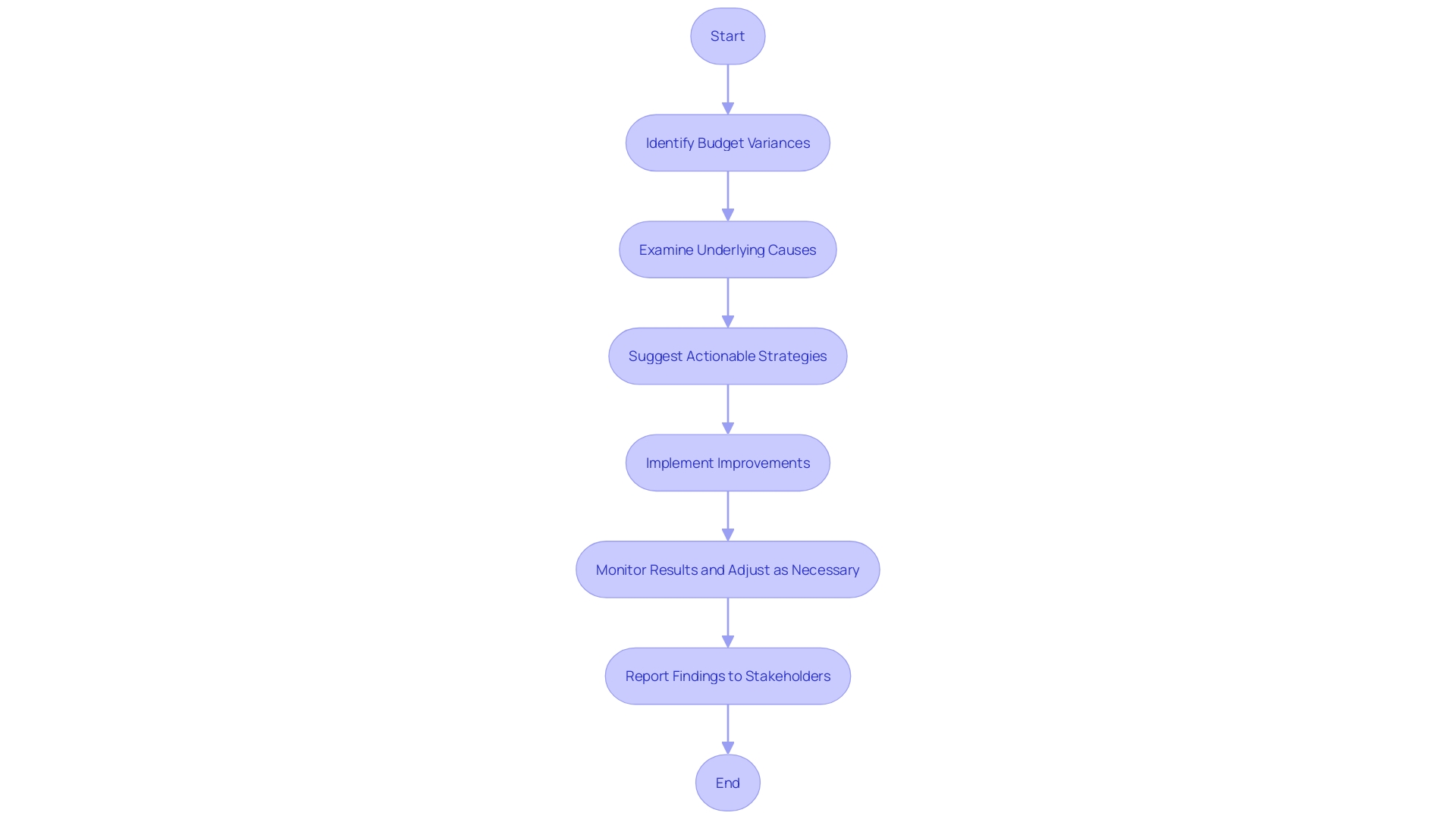
Best Practices for Budget Variance Analysis
Mastering budget variance analysis is crucial for a CFO to steer their organization towards financial stability and strategic growth. It requires setting benchmarks that are both challenging yet attainable, and continuously tracking performance against these targets. This means routinely reviewing financial data to ensure accuracy and reliability, which is the foundation for meaningful insights and decisions.
Involving stakeholders not just brings diversity of perspective but also fosters accountability and ownership over the financial outcomes. As each line item in the budget is examined, stakeholders should justify the expenditure, ensuring alignment with organizational goals and evaluating the expected return on investment (ROI).
Communication is equally critical. Sharing the outcomes of the budget variance analysis with relevant parties ensures transparency and enables informed decision-making. It's about creating a narrative that explains the 'why' behind the numbers, guiding the organization to adapt and thrive in a dynamic business environment.
-
Set clear and realistic budget targets: Establish benchmarks that reflect both ambition and feasibility, ensuring they are grounded in solid data and strategic objectives.
-
Regularly monitor and update the budget: Foster a culture of continuous improvement by periodically reviewing financial performance against the set targets.
-
Use reliable and accurate financial data: Ensure that the data driving budgetary decisions are precise and reflective of the organization's reality.
-
Involve key stakeholders in the analysis process: Engage diverse perspectives to validate the budget plan and its execution, promoting accountability.
-
Communicate the analysis findings and recommendations effectively: Articulate the insights drawn from the variance analysis in a way that is understandable and actionable for all stakeholders.
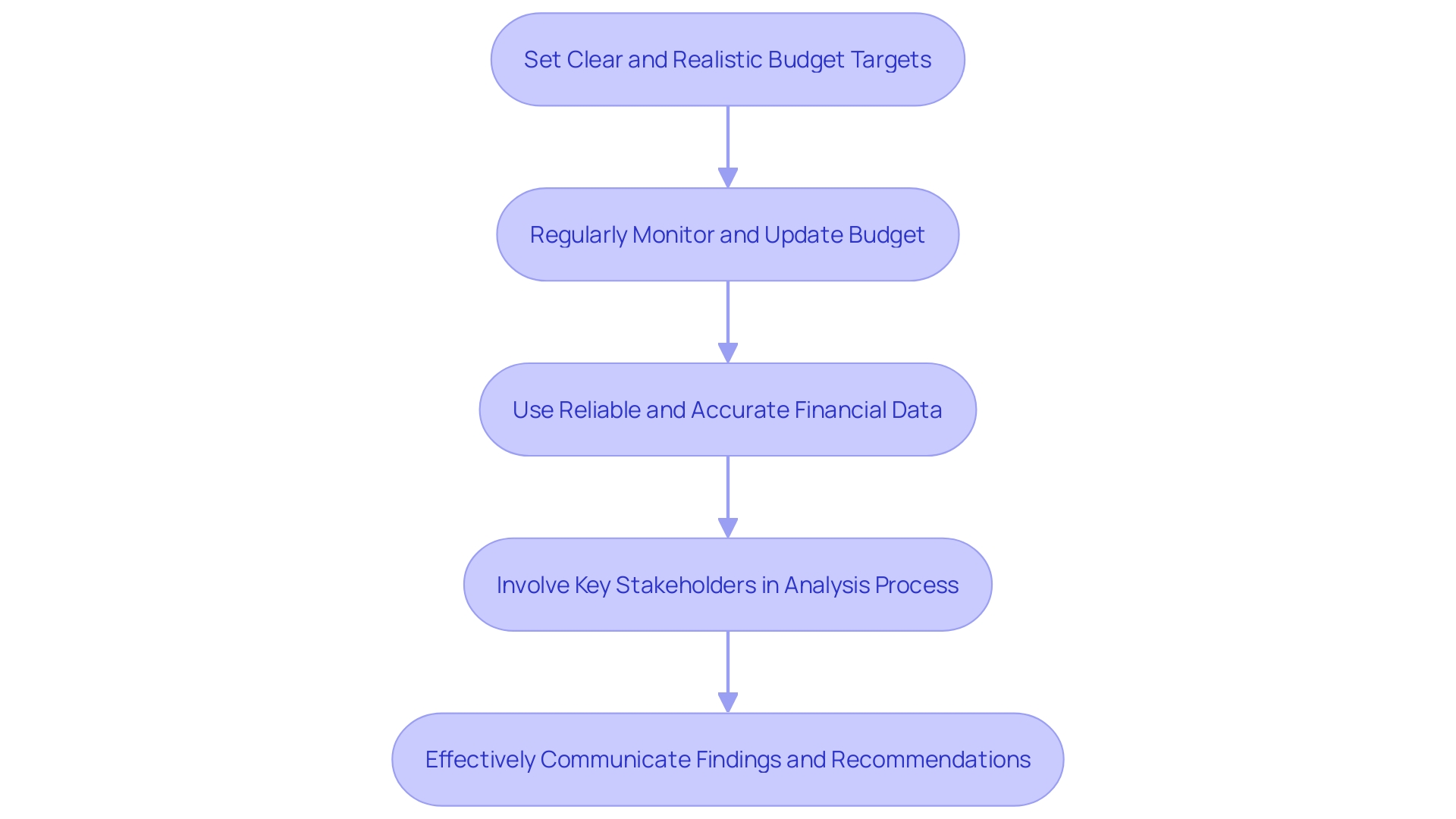
Common Challenges and Solutions
Conducting a budget versus actual variance analysis is integral to financial management, but it can be fraught with hurdles. One may encounter issues such as misjudged budget projections or difficulty in pinpointing the root causes behind the divergences. Collecting precise and current financial data can also pose a challenge. To enhance the efficiency of budgeting activities, it's crucial for businesses to incorporate strategies like periodic budget assessments and adjustments. Improving the mechanisms for data gathering and processing can significantly aid in this process. Additionally, investing in the education and training of personnel on budgetary and financial analytical methods can empower them to manage and interpret financial information more effectively.
For instance, the adoption of zero-based budgeting (ZBB) demonstrates a proactive approach wherein every expense must be justified for each new period, disregarding historical spending patterns. This method encourages meticulous examination of each budget item, fostering a culture of cost-control and accountability. Furthermore, aligning your budgeting process with your organization's long-term strategic plan enables you to set clear financial and operational targets. Comparing actual outcomes against these targets helps maintain focus on high-profit initiatives, while also providing the flexibility to adapt to changing business needs.
In light of the dynamic nature of business environments, as Jurgen Appelo points out, clinging to an outdated annual budgeting cycle can be detrimental. Organizations must pivot towards more fluid and responsive financial planning techniques that reflect actual performance. Moreover, constantly evaluating the return on investment for various organizational expenditures, as suggested in the query, "Should I really be spending money on ___?" is essential for making informed decisions that contribute to organizational growth.
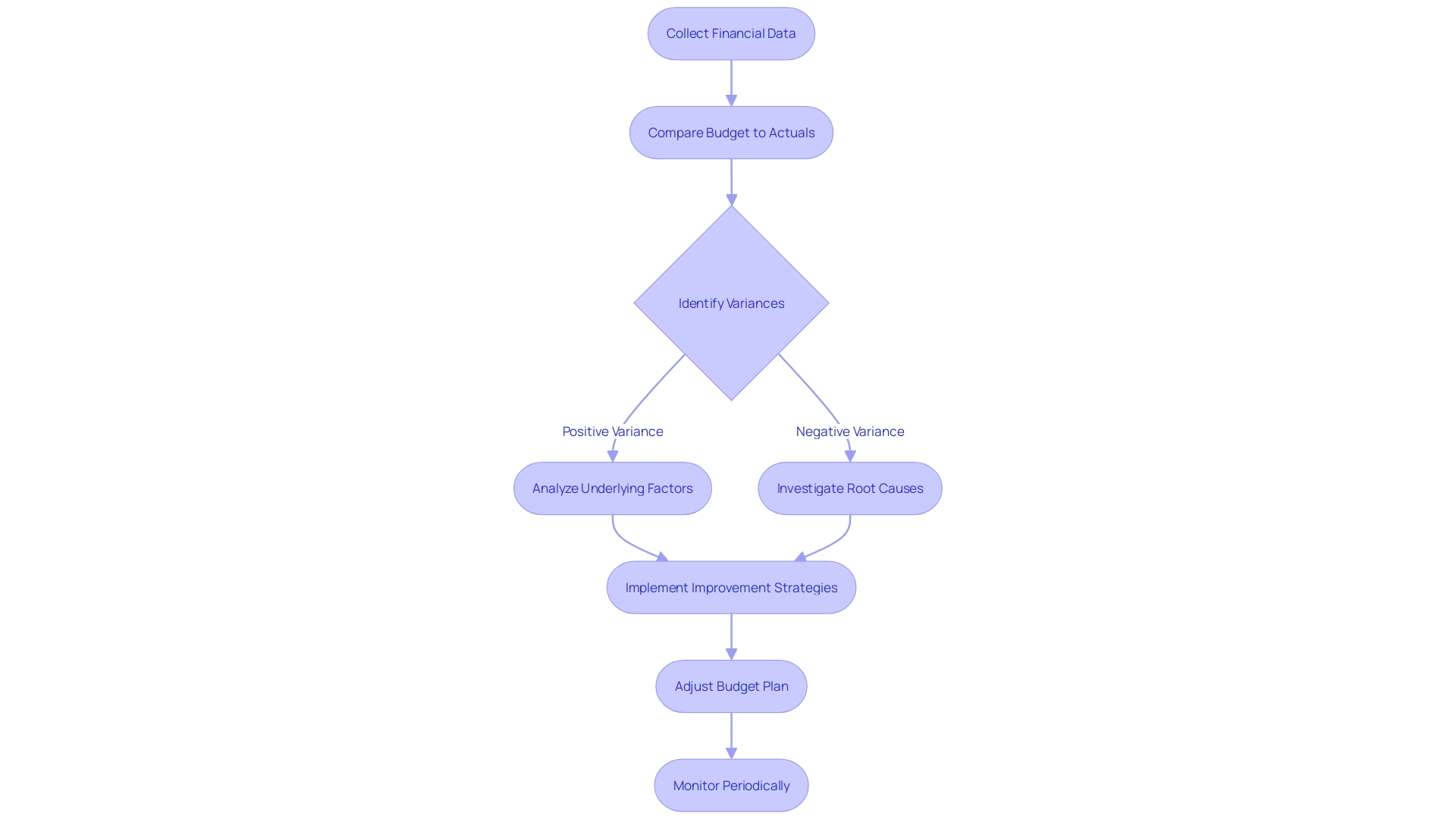
Conclusion
Budget Variance Analysis is a critical tool for aligning financial expectations with operational reality. By comparing projections with actuals, financial leaders can refine forecasting methods and uncover the narratives behind deviations. This article has highlighted the importance of budget variances, calculating and interpreting them, and best practices for conducting a budget variance analysis.
Analyzing budget variances is essential for businesses to stay competitive in evolving financial landscapes. It reflects operational efficiency, cash flow understanding, and effective resource management. Calculating budget variance and percentage variance provides valuable insights into areas of overperformance or underperformance, guiding future spending and investment decisions.
Interpreting and analyzing variances involves defining the problem, collecting relevant data, and implementing corrective measures. Incorporating these insights into business operations enables informed decision-making and optimization of financial performance. Effective budget variance analysis requires collating projected budgets and actual financial figures, determining variances, delving into underlying causes, implementing corrective measures, and continuously monitoring performance.
Creating a comprehensive budget variance report goes beyond comparing numbers. It provides insights into spending efficacy, encourages cost-control, and fosters accountability. Involving stakeholders, fostering communication, and setting clear and realistic budget targets are essential best practices for budget variance analysis.
Mastering budget variance analysis is crucial for CFOs to steer their organizations toward financial stability and growth. It involves setting realistic targets, using reliable financial data, involving key stakeholders, and effectively communicating analysis findings and recommendations.
In conclusion, budget variance analysis is a dynamic process that requires continuous monitoring and adaptation. By embracing best practices and overcoming common challenges, organizations can optimize their financial performance and achieve their long-term goals.




